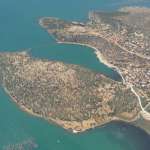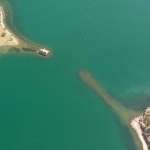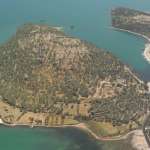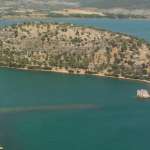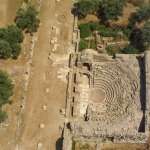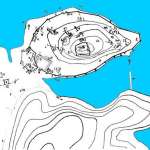Iassos
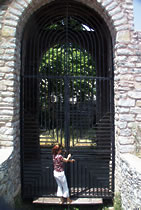 At the shores of Güllük there is one of the loveliest ruins of the Aegeans shores, Iassos. Rercently, when we went there to deal with a broken gearbox, the owner of the elegant yacht, an old friend of mine, WN, almost whispered to me: “You must see the museum. It is enchanting”. So, before leaving we visited the museum. It was well worth while.
At the shores of Güllük there is one of the loveliest ruins of the Aegeans shores, Iassos. Rercently, when we went there to deal with a broken gearbox, the owner of the elegant yacht, an old friend of mine, WN, almost whispered to me: “You must see the museum. It is enchanting”. So, before leaving we visited the museum. It was well worth while.
Firstly, in order to enter the museum, you have to pick up the “curator”. Her name is Sibel, and she is to be found at the booth at the entrance of the ruins. She comes with you the walking distance to the “old fishmarket”, which is the museum today. For me as a layman, more than the lovely findings stored in the museum and labeled generously in English, the main attraction is the mausoleion. Yes, in the center of the Hellenistic fishmarket you can find a “small” and beautiful mausoleion. All the time I was in the museum, I spent imagining Alexander’s soldiers bargaining for the fresh catch around the mausolein.
Iassos is a must for the visiting yachsperson. Several fish restauarants are available at the shore. Mind the sunken harbour mole at the entrance. Mind also that the little harbour is especially sensitive to black and gray water.
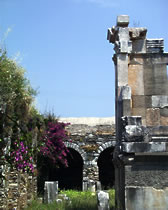 It is a located on a peninsula, surrounded by sea on three sides, within the boundries of the Kiyikislacik village, at a distance of 28 kms. from Milas. According to the legend, it was founded by arrivals from Argos, and was named after their leader, lassos. There is no mention of lassos in sources dated earlier than the fifth century B.C. The city was originally founded on an island and subsequently, when the isthmus was filled up, it became a peninsula. The significant ruins of the antique city are located on this peninsula. The high city walls, the aquaducts, necropolis and the building called the fish market are beyond the walls. The excavations at lassos revealed that the oldest settlement in the city dates back to the end of the third century B.C.
It is a located on a peninsula, surrounded by sea on three sides, within the boundries of the Kiyikislacik village, at a distance of 28 kms. from Milas. According to the legend, it was founded by arrivals from Argos, and was named after their leader, lassos. There is no mention of lassos in sources dated earlier than the fifth century B.C. The city was originally founded on an island and subsequently, when the isthmus was filled up, it became a peninsula. The significant ruins of the antique city are located on this peninsula. The high city walls, the aquaducts, necropolis and the building called the fish market are beyond the walls. The excavations at lassos revealed that the oldest settlement in the city dates back to the end of the third century B.C.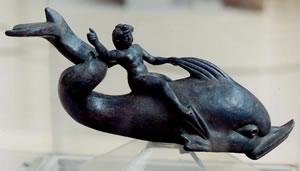
When Alexander besieged Miletos in 334 B.C., lassos donated a ship to the Persian navy to assist in the defense of the city. Ten years later, Alexander’s armoury at Ekbatan was commandeered by an lasian named Gorges. Another lasian favoured by Alexander was a boy who had the peculiar fate of being loved by a dolphin . In lasos, it was customary for boys to wade into the sea after practicing at the Gymnasium. At that time a dolphin came ashore and carted one of the boys away on its back , eventually bringing him back to the shore. The legend says that Alexander, hearing of this strange tale, summoned the boy to Babylon and appointed him as a priest of Poseidon, the God of the Sea. The lasians were so greatly influenced by this tale that on the coins they minted in the third century B.C. there is an illustration of a boy swimming alongside a dolphin, with his arm thrown over its back.
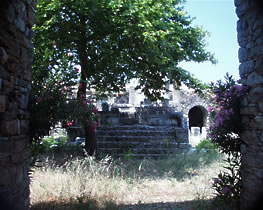 TJie Agora is reached through an arched gate. The Bouteterion is in the southwest of the Agora. In the eastern corner of the Agora, the building with the dimensions of 17 x 13 meters and with columns in the front is identified as the Caesereon. In the southwestern corner of the Agora, there is the Temple of Artemis Astias. The theatre is constructed on the northeastern slope of the hill at the center of the town. The medieval fortress is located on the highest point of the city and in the town center. The harbour is between the peninsula and the mainland with a length of approximately 850 meters. The tower at the mouth of the harbour is part of the wave-breakers and is from the medieval times. The other tower facing this is demolished. At the time they were used, a chain was stretched in between to prevent entrance into the harbour of undesitable vessels. The Agora within the city was used as a necropolis in the archaic period. There are tombs carved into rocks and house tombs on the slopes to the west of the Roman necropolis.
TJie Agora is reached through an arched gate. The Bouteterion is in the southwest of the Agora. In the eastern corner of the Agora, the building with the dimensions of 17 x 13 meters and with columns in the front is identified as the Caesereon. In the southwestern corner of the Agora, there is the Temple of Artemis Astias. The theatre is constructed on the northeastern slope of the hill at the center of the town. The medieval fortress is located on the highest point of the city and in the town center. The harbour is between the peninsula and the mainland with a length of approximately 850 meters. The tower at the mouth of the harbour is part of the wave-breakers and is from the medieval times. The other tower facing this is demolished. At the time they were used, a chain was stretched in between to prevent entrance into the harbour of undesitable vessels. The Agora within the city was used as a necropolis in the archaic period. There are tombs carved into rocks and house tombs on the slopes to the west of the Roman necropolis.
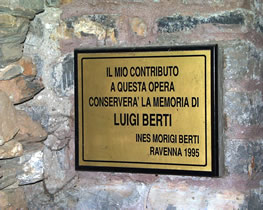 The most significant tomb in the city is the monumental one from the Roman period, popularly called the Mausoleum of the Fish Market. The restoration of this mausoleum was instigated in 1993 by funds allocated by the General Directorate of Rotating Capital Operations of the Ministry of Culture, and the architectural pieces and works of art, unearthed by the excavations at lassos, are now in exhibit in the galleries restored. The Fish Market Open-Air Museum was opened to the public on 11 August, 1995.
The most significant tomb in the city is the monumental one from the Roman period, popularly called the Mausoleum of the Fish Market. The restoration of this mausoleum was instigated in 1993 by funds allocated by the General Directorate of Rotating Capital Operations of the Ministry of Culture, and the architectural pieces and works of art, unearthed by the excavations at lassos, are now in exhibit in the galleries restored. The Fish Market Open-Air Museum was opened to the public on 11 August, 1995.
The lassos excavations were started in 1960 by an Italian Archaeological Team, headed by Prof. Doro LEVI and presently presided by Dr. Fede BERTI.
From: The Guide of Museums and Accessible Sites, Directorate of Culture, Mugla, April 2002
Some related links:
http://www.akyaka.org/tarih/history/milas.html
http://www.snible.org/coins/hn/caria.html
Plan of lasos
1) Temple on the acropolis.
2) Early Christian basilica.
3) Wall of the acropolis.
4) Excavated area east of the acropolis.
5) Theatre quarter.
6) Theatre.
7) Basilica.
8) City-gate.
9) Roman Agora.
10) Roman Bouleuterion.,
11) Stoa, dedicated to Artemis and the Emperor Corn-modus (A. D. 180-192).
12) Sanctuary of Demeter and Kore.
13) House with mosaic.
14) Tomb on the isthmus.
15) Mausoleum, excellently restored by the Italian expedition.
16) Necropolis.
17) Excavation House
a) Remains of Greek periods
b) Medieval castle
c) Byzantine castle,
d) Aqueduct,
e) Early Christian church
f) Byzantine structure,
g) Wall of the acropolis,
h) Cistern.
i) Fountain.
l) Greek temple
m) Quay or mole
n) Roman temple,
o) Roman structure,
p) Dipylon.
q) Gymnasium
r) Roman House,
s) Modern road.
t) Roman baths.
Plan and Legend from Ekrem Akurgal, Ancient Ruins and Civilizations of Turkey, Istanbul, 1985
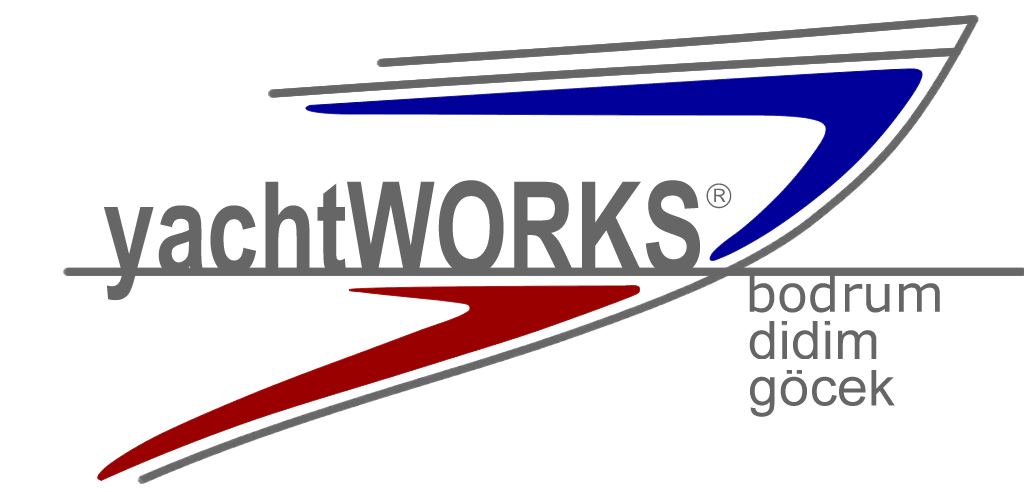

 English
English Turkish
Turkish Русский
Русский